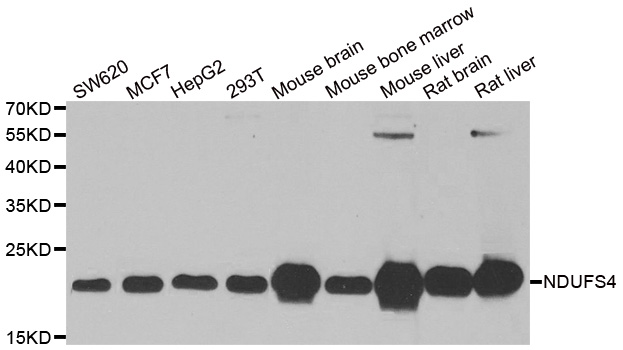NDUFS4 antibody
GTX105662
ApplicationsImmunoFluorescence, Western Blot, ImmunoCytoChemistry, ImmunoHistoChemistry, ImmunoHistoChemistry Paraffin
Product group Antibodies
TargetNDUFS4
Overview
- SupplierGeneTex
- Product NameNDUFS4 antibody
- Delivery Days Customer9
- Application Supplier NoteWB: 1:500-1:3000. ICC/IF: 1:100-1:1000. IHC-P: 1:100-1:1000. *Optimal dilutions/concentrations should be determined by the researcher.Not tested in other applications.
- ApplicationsImmunoFluorescence, Western Blot, ImmunoCytoChemistry, ImmunoHistoChemistry, ImmunoHistoChemistry Paraffin
- CertificationResearch Use Only
- ClonalityPolyclonal
- Concentration1 mg/ml
- ConjugateUnconjugated
- Gene ID4724
- Target nameNDUFS4
- Target descriptionNADH:ubiquinone oxidoreductase subunit S4
- Target synonymsAQDQ, CI-18, CI-18 kDa, CI-AQDQ, MC1DN1, NADH dehydrogenase [ubiquinone] iron-sulfur protein 4, mitochondrial, NADH dehydrogenase (ubiquinone) Fe-S protein 4, 18kDa (NADH-coenzyme Q reductase), NADH-ubiquinone oxidoreductase 18 kDa subunit, complex I 18kDa subunit, complex I-AQDQ, mitochondrial respiratory chain complex I (18-KD subunit)
- HostRabbit
- IsotypeIgG
- Protein IDO43181
- Protein NameNADH dehydrogenase [ubiquinone] iron-sulfur protein 4, mitochondrial
- Scientific DescriptionThis gene encodes an accessory subunit of the mitochondrial membrane respiratory chain NADH dehydrogenase (Complex I), or NADH:ubiquinone oxidoreductase, the first multi-subunit enzyme complex of the mitochondrial respiratory chain. Complex I plays a vital role in cellular ATP production, the primary source of energy for many crucial processes in living cells. It removes electrons from NADH and passes them by a series of different protein-coupled redox centers to the electron acceptor ubiquinone. In well-coupled mitochondria, the electron flux leads to ATP generation via the building of a proton gradient across the inner membrane. Complex I is composed of at least 41 subunits, of which 7 are encoded by the mitochondrial genome and the remainder by nuclear genes. [provided by RefSeq]
- Storage Instruction-20°C or -80°C,2°C to 8°C
- UNSPSC12352203
References
- Lim SC, Hroudová J, Van Bergen NJ, et al. Loss of mitochondrial DNA-encoded protein ND1 results in disruption of complex I biogenesis during early stages of assembly. FASEB J. 2016,30(6):2236-48. doi: 10.1096/fj.201500137RRead this paper




